This is part of our series of informational tips for volunteer foster families.
Consider making a long-term difference through short-term care by signing up to foster animals in need.
Occasionally after surgery, cats and kittens can have an adverse behavioral reaction to anesthesia. Behaviors you may see include, but are not limited to: hissing, growling, and swatting and may be towards people or other animals including their family members. These behaviors typically diminish as more time passes and the anesthetic agents wear off. Cats and kittens are typically back to their previous dispositions 24 hours post-operative, although it can take longer. Sometimes the way the cats smell after surgery can confuse their furry family and they don’t recognize each other.

If you notice any of these behaviors when you pick the kittens up, please request additional crate(s) from the staff. When you get home, you will want to provide these grumpy felines with their own space with food, water, and litterbox access. If you do not have enough supplies to separate them, you can either request to pick up more supplies or use household items. For food and water bowls, you can use small shallow bowls or Tupperware. For litterboxes, you can use the cardboard container that holds the wet food or other similarly sized boxes that can be disposed of. If you have disposable foil pans, you could use those too. If you worry that you don’t have enough space for each to have their separate housing, you can use large crates that fits all the necessary supplies, or use household items to divide the space they are already in. Have a shower stall? Now it’s a temporary kitten condo! Have cardboard boxes laying around? Fashion some high walls within the space so everyone can have some privacy.
The day after surgery, if the cats and kittens seem to be doing better, you can begin to reintroduce them. We recommend doing reintroductions one on one in a space that allows for them both to have an opportunity to put distance between each other. If introductions go well, keep it up! If you notice a poor reaction, use a wand or other toy to distract and separate. Do not put your hands in a scuffle. We do not want them to unintentionally redirect their frustration or dysphoria on you.
These behaviors can look and sound scary. Please do not take it to heart, they are in a dysphoric state and likely do not recognize you or their family members. You can reach out to the Foster Department, Clinic Department, or Behavior Department for further assistance about the post-operative behaviors you are seeing, as well as, for reintroduction help!
For information about post-operative medical care, please reference our Post-Operation Instructions and Care blog post.


